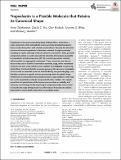Tropoelastin is a Flexible Molecule that Retains its Canonical Shape
Author(s)
Tarakanova, Anna; Yeo, Giselle C.; Baldock, Clair; Weiss, Anthony S.; Buehler, Markus J
DownloadPublished version (3.031Mb)
Publisher with Creative Commons License
Publisher with Creative Commons License
Creative Commons Attribution
Terms of use
Metadata
Show full item recordAbstract
Tropoelastin is the dominant building block of elastic fibers, which form a major component of the extracellular matrix, providing structural support to tissues and imbuing them with elasticity and resilience. Recently, the atomistic structure of human tropoelastin is described, obtained through accelerated sampling via replica exchange molecular dynamics simulations. Here, principal component analysis is used to consider the ensemble of structures accessible to tropoelastin at body temperature (37 °C) at which tropoelastin naturally self-assembles into aggregated coacervates. These coacervates are relevant because they are an essential intermediate assembly stage, where tropoelastin molecules are then cross-linked at lysine residues and integrated into growing elastic fibers. It is found that the ensemble preserves the canonical tropoelastin structure with an extended molecular body flanked by two protruding legs, and identifies variations in specific domain positioning within this global shape. Furthermore, it is found that lysine residues show a large variation in their location on the tropoelastin molecule compared with other residues. It is hypothesized that this perturbation of the lysines increases their accessibility and enhances cross-linking. Finally, the principal component modes are extracted to describe the range of tropoelastin's conformational fluctuation to validate tropoelastin's scissor-twist motion that was predicted earlier.
Date issued
2018-10Department
Massachusetts Institute of Technology. Department of Civil and Environmental EngineeringJournal
Macromolecular Bioscience
Publisher
Wiley
Citation
Tarakanova, Anna et al. "Tropoelastin is a Flexible Molecule that Retains its Canonical Shape." Macromolecular Bioscience 19, 3 (October 2018): 1800250 © 2018 WILEY-VCH Verlag GmbH & Co. KGaA, Weinheim
Version: Final published version
ISSN
1616-5187
1616-5195